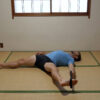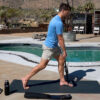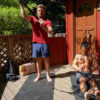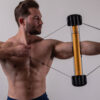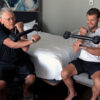Isometrics, such as the isometric squat, is one of the most underutilized exercises. Too often, mainstream media depicts those who favor explosive power movements and other traditional exercises such as cardio and yoga. However, by not incorporating the isometric squat and other isometric exercises into your training routine, you miss out on a simple way to build muscle endurance.
Isotonic vs. Isometric – How to Decide?
Isometric squats belong to a group of exercises that utilize contractions without moving the joints. When using an isometric position, your muscles will push or pull against each other and thus create resistance. By placing this constant tension on your muscles, you will improve your overall muscle endurance. Moreover, isometrics can support your isotonic exercises (weightlifting).
When used together, isotonic and isometric exercises allow for a balanced workout routine that targets muscle strength, stability, and endurance. At the same time, isotonic exercises use concentric or eccentric movements, which shorten and lengthen the muscles.
Isometric exercises, on the other hand, won’t cause the muscles to contract at all. Instead, the body is held in a static position, which causes your muscle tissue to fill with blood and place metabolic stress on the muscles used.
The History of Isometrics
In the 1950s, the German researchers Muller and Hettinger made an exciting discovery about isometrics. Essentially, they found that a muscle will only grow and gain strength if the contraction is more significant than 1/3 of its maximum strength.
Achieving this measurement can be done accurately by using a piece of equipment known as a dynamometer; however, if a dynamometer is unavailable, such as when someone is training in their home, one can be trained on how to “feel” this level of effort using a scale (a modified RPE, or rating of perceived exertion scale).
This finding, in turn, led to the creation of a training program that involves the use of isometrics for strength gains in athletes, rehabilitation guidelines for those who were immobilized due to injury or surgery, and for those with heart issues.
Strength Gains for Athletes
Bodybuilders and other athletes have used isometrics for many years to tap increase their strength. Physiologists have found that a well-structured isometric program can lead to strength gains equal to conventional weightlifting and bodybuilding techniques.
Additionally, equipment is not needed for isometric exercises. When athletes are unable to make it to a gym and use equipment, they can opt to do isometric exercises to supplement their workouts.
Rehabilitation Guidelines
After suffering a significant injury, or undergoing certain surgeries, often, the patient will be immobilized in one way or another. Before understanding the benefits of isometrics, patients were instructed to keep the injured area still to heal.
This led to long-term problems in which patients had significant muscle loss and dysfunction. Now, the importance of incorporating early exercise is well-understood. Physical therapists and others in rehabilitation teams utilize movements such as the isometric squat and various other loading techniques as soon as the patient can tolerate them. These movements are generally thought to be safer for a healing area than a traditional isotonic movement.
Not Recommended for Heart Problems
Heart problems are a hot topic when it comes to isometric exercise. While studies have found that appropriately scaled isometric training programs are generally safe for individuals with heart issues, many doctors still advise against the use of isometrics in their patients.
Above, we discussed how isometric exercises flow blood to the muscles you are working on, and this can be dangerous for those with serious heart problems because the blood flow can quickly increase heart rate and blood pressure. While it will depend on the individual, aerobic, not isometric, activities are recommended for heart problems.
Always consult with your doctor before beginning any exercise program, regardless of your particular medical issues and needs.
Benefits of Isometrics
While many believe that isotonic weightlifting is the only way to strengthen their bodies, they are greatly mistaken. There are many benefits to performing isometric exercises, such as:
- Engages all the muscle fibers at once.
- Can be used as beginner exercises to practice good form before adding movement and weight.
- Suitable for those with physical injuries and conditions, such as osteoarthritis.
- If used consistently, isometrics can lower blood pressure.
- Improves muscle stability and endurance.
- May help with pain relief in the lower back and neck.
The Isometric Squat vs. The Isotonic Squat
When planning your exercise routine, you should consider both isometric and isotonic exercises. While there are distinct differences between isometric squats and isotonic squats, you should consider incorporating both of them.
Space and Equipment Requirements
When performing isotonic squats, at some point, you are going to want to increase volumes of resistance or duration.
Isometrics do not require extra weight. Although you can add weight to isometrics for greater difficulty, simply lengthening the time you hold an exercise or adding more reps will be sufficient.
An isometric squat training program, on the other hand, requires very little space and very little equipment.
Bullworker offers you compact pieces of equipment that can be easily stored and used virtually everywhere for isometric training. In utilizing Bullworker products, no matter the circumstances, you will have a way to continue to increase your squat capabilities and general leg strength by tapping into the power of isometrics.
Performance vs. Strength
A study from 2018 found that isometric exercise should be prioritized over isotonic exercise when strength gains are the primary goal. Additionally, isotonic and isokinetic (another type of exercise mainly used in research) resulted in improvements in functional performance.
Therefore, it is good to vary your training and program your routine based on your main goal.
How to Do an Isometric Squat
When performing a proper isometric squat, there are key pieces of the technique to incorporate to get the most out of the exercise. Because the isometric squat is a variation of the traditional squat, the proper form resembles that of a squat. To do an isometric squat use the following steps:
1. Stand with your feet shoulder width apart.
This wider stance will allow for a comprehensive movement that will engage the hips on three separate planes and distribute weight evenly across the body.
2. Slowly bend your knees and push your hips backwards.
The slow movement into the squat will help you engage all the correct muscles and get deeper into the squat position.
3. Lower into the squat position.
When first learning how to squat correctly, it’s best to use a mirror to watch your form. For the most efficient squat form, the lowest point of the squat should make it look like you are sitting in a chair. Sometimes, it can be helpful to place a stool directly underneath your bottom to help ensure you are low enough. Simply tap the stool with your bottom as you lower yourself down and hover over the stool as you hold.
4. Once in squat position, place your arms out in front of you to aid with balance.
Your arms will help steady your body and will also engage your shoulders for even more challenge. For a level up, try raising your hands directly towards the sky.
5. Hold the position for your specified period of time.
Holding the isometric squat is the key to developing muscle endurance.
6. Slowly move upward and to a standing position.
By moving slowly, you continue to engage your muscles.
Common Pitfalls to Watch For
Maintaining your form is one of the most important aspects for doing an isometric squat. So when squatting, make sure you pay attention to a few key areas to make sure you are getting the most out of your workout:
- Keep your heels on the floor. If you lift them up, your body will not transfer force evenly.
- Keep your knees above your toes. While some people can get away with extending the top of the knee over their toes, it may cause knee pain for others.
- Do not move your knees inward. This is known as a valgus position and can place too much pressure on your knee joints.
- Go deep into your squat. If you only go halfway down, you will not be getting the most out of the exercise. Squat down as deep as you can.
How to Incorporate the Isometric Squat into Your Training Routine
Frequency
There are numerous resources that all have various opinions on how frequently a lifter should train legs. However, if you are performing isometrics, a general recommendation is to train legs three times per week, with at least 48 hours of rest between sessions.
Duration
The Russian sports scientist Yuri Verkhoshansky, an advocate for isometric training in athletes, suggests that isometric workouts should last no longer than 10 minutes per exercise session. In this case, 10 minutes means that the “time under tension” will be 10 minutes, not the total time you are in the gym. Therefore, if you did 5 x 10-second holds at the bottom squat position, you’d have performed 50 seconds of your total workout.
In terms of each isometric contraction duration, research varies widely, but much consensus exists around 4-6 second contractions. However, many coaches suggest 10-second holds. An individual’s recommendation will depend mainly on the person’s unique training status and goals.
Bullworker suggests a 7-10 second hold.
Angles
With isometrics comes the inherent problem that the lifter is not hitting all ranges of motion with each isometric effort. Therefore, different angles must be emphasized for each muscle group. For the isometric squat, one recommendation is to break the movement down into angles. One study found that during an isometric squat, the glute and quad muscles were the most engaged when the individual’s knees were at a 90-degree angle. Alternatively, the muscles were the least engage when the knee was positioned at a 140-degree angle (deep squat).
To achieve the most efficient squat, bend your knees so that they resemble an “L” shape. If you go any lower than that, your squat will not engage the correct muscles. Additionally, and shallower and you will not be squatting deep enough.
Equipment/Movement Variations
There are many ways to perform isometric exercise ranging from highly complex and expensive equipment to free, bodyweight exercise. Using weights, resistance bands, body weight, and with Bullworker products, you can perform isometric squats in several ways.
Unlike other workout products, the Bullworker brand offers several products that target the entire body. By increasing flexibility and endurance, these products are guaranteed to improve your physical performance. For example, the ISO-FLO is designed to target the entire body and is light enough to be taken anywhere. Or maybe, you are interested in adding an upper-body routine to your isometric lower body exercises. If that is the case, then the Bow Classic all-in-one gym is the perfect addition to target every muscle group.
If you are looking for more variations to add to your isometric squat routine, consider changing your body stance or adding resistance. Keep in mind that each of these positions are to be held if you are doing isometrics.
When you perform each of the squat variations below, you will be holding the position for a set period. Additionally, you may start without weights and build up to adding them as you increase your workout intensity.
Back Squat
The back squat is one of the best ways to enhance performance according to this study by NCBI. This movement is performed by holding a barbell across the top of your shoulders, behind your neck and slowly squatting down into a sitting position. Perhaps the most traditional squat movement, this squat will target your glutes, quads, and hips. When first performing this squat, warm up your lower body by jogging or squatting without weight.
Front Squat
The front squat engages you core, upper back, and will help increase leg strength. Having become increasingly popular with CrossFit, the front squat will place more emphasis on the quads than traditional squatting methods. The front squat variation, can be performed with the ISO-FLO connected with your Bow Classic or holding a bar in front of the shoulders and your forearms reach back over the elbow to grab the bar. When doing this type of squat, it may be best to use a clean grip and keep your elbows and chest pointed up.
Hack Squat
The hack squat is advantageous because it is one of the best varieties for improving quad strength and takes compression off the spine. Similar to a deadlift—but backwards—this squat is done by placing your ISO-FLO connection behind you and grabbing the handles with your palms facing backward. Start with relatively low resistance until you get comfortable to the movements involved with this squat.
Dumbbell Squats
While squatting using the same lower body squatting technique, you can incorporate the use of hand weights into your routine. When choosing your dumbbell weights, you will want weights that are light enough to be held for longer periods. So if you cannot hold the weights at shoulder height for more than a few seconds, the weights may be too heavy. In this variation, the lifter can hold dumbbells in many positions: overhead, sides at shoulders like in a front squat.
Bullworker Squat and Deadlift
Utilizing Bullworker products, one can perform a squat or, perhaps more accurately, a deadlift. The device makes it easy to get a great workout anywhere you are by quickly changing positions and utilizing the various attachments. You can add Bullworker products to engage your entire body as you move in and out of the squat position. The muscles worked are the same as in the other movements listed, just in different proportions.
Complementary Movements to Include with the Isometric Squat
- Hamstring Curls: The hamstrings are complex, multi-joint muscles. During a squat, lunge, or deadlift movement, the hamstrings are contracted at their upper portion but mainly relaxed at their lower portion. To keep balance across all leg muscles, it is good to perform hamstring curls regularly.
- Hip Abduction and Adduction: Hip abduction and adduction exercises can easily be done at home without equipment by performing a wide leg squat or by laying on the ground and doing side leg raises. Your Bullworker also provides you with an enhanced version of these exercises with various resistances for optimum training. These muscles can be worked in several ways outside of the traditional machine version. By doing these exercises, you can avoid overuse injuries in your knees and iliotibial (IT) band. However, they must be exercised occasionally to avoid over-stressing the hips by working them only in the direction that squats emphasize.
- Dorsiflexion: The muscle on the front of your shin, the tibialis anterior, as well as a few other muscles to a lesser extent, are responsible for the movement known as dorsiflexion. Dorsiflexion is the act of bringing your toes upward. This muscle is important for ankle stability and gets little use during the squat, as the plantar flexors (the calf muscles) are more active during the movement.
Other Healthy Habits to Incorporate with your Isometric Squat Routine
It would be nice if there were just one exercise or even just one type of exercise best for overall health. Unfortunately, that is not the case, and we need to pull from a lot of different areas to achieve optimal health.
- Cardiovascular Exercise: The heart and lungs are essential for our health; this can’t be overstated. Everyone should aim for at least 150 minutes of moderate-intensity cardiovascular exercise such as walking, running, or swimming every week.
- Flexibility Exercise: Whether you prefer to do a formal yoga routine or just some simple stretches at home, you should make an effort to incorporate flexibility exercise into your routine. Having flexibility allows you to achieve greater ranges of motion when you are performing other types of exercise as well as relieves tension, aids in recovery, and improves muscular balance throughout your daily routine. The ISO-BOW is a helpful tool for making stretching easier for the beginner and enhancing other stretches for the advanced yogi.
- A Proper Diet: As with anything in the exercise world, gains start in the kitchen. If you don’t have an adequate nutrition plan which optimizes your calorie and nutrient needs for your training goals, you will have a much harder time succeeding.
Bottom Line
If your fitness goals include increasing leg strength, you must incorporate an isometric squat routine into your program. Isometric is a research-backed method to increase muscle size and strength.
If you are looking for a new piece of equipment to add to your routine, making performing isometrics simple and straightforward, you might consider a Bullworker. The equipment is compact, built to last, affordable, and incredibly effective. While gyms and fancy exercise equipment certainly have their place in the fitness world, there is no substitute for good, hard work. The Bullworker provides resistance to give everyone, at any level of fitness, an excellent workout. Don’t believe us? Give it a try and find out, risk free!
